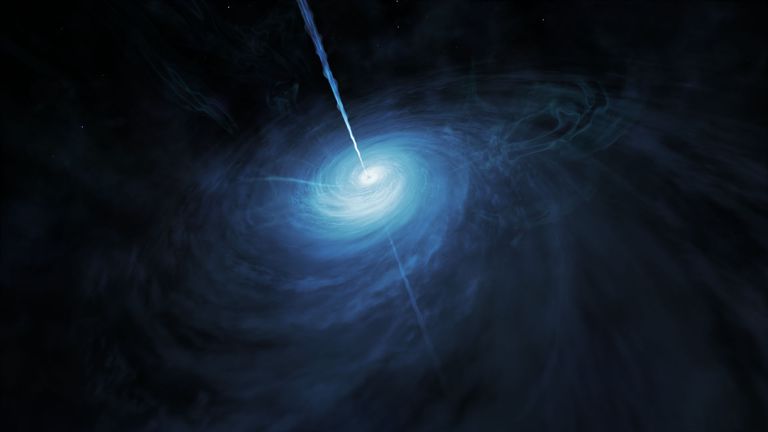[ad_1]
Scientists have discovered a so-called “missing-link” supermassive black hole hidden not in the depths of space, but in archive data.
According to the international research team behind the discovery, the cosmic object could be the clue humanity has been searching for to explain the evolution of quasars.
Even more than the light it may shed on the brightest objects in space, the discovery suggests many more surprises may be waiting to be uncovered in archive data.
Read more: Secrets of supermassive black hole revealed
Quasars are the brightest known objects in space, with the brightest ever – discovered three years ago by the Hubble Telescope – as bright as 600 trillion Suns.
They are powered by matter collapsing into a supermassive black hole formed in the early history of the universe, just hundreds of millions of years after the Big Bang.
Quasars are believed have evolved from black holes in dusty starburst galaxies, which are also believed to have existed in this period.
However, until the paper published in the journal Nature this week, there has been no direct evidence linking quasars with this class of galaxy.
The evidence of the missing link was found while analysing archived data captured by the Hubble Space Telescope.
This data is from a region of the sky in the constellation Ursa Major known as the Hubble GOODS North Field which has has been studied extensively by astronomers.
Buried in it the team noticed an object that appears to be a black hole “just starting to overpower its host galaxy in the process of becoming a quasar”, say the researchers.
They turned to additional archive data from the Subaru Telescope, which can see farther into the infrared wavelengths than Hubble, allowing them to distinguish the host galaxy from the black hole itself.
Our ability to see into the infrared spectrum is set to be boosted by NASA’s new James Webb Space Telescope, which is the most powerful telescope in history, and was launched last year.
Seiji Fujimoto, the lead author of the new paper, said: “Subaru Telescope’s Hyper Suprime-Cam has also discovered a large number of quasars in the early universe.
“Further observations with the ALMA radio telescope and the James Webb [Space Telescope] have been scheduled.
“Detailed analysis at multiple wavelengths with a combination of these telescopes may find even more objects like GNz7q in the future,” he added.
[ad_2]









